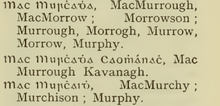Mac Murchadha
Mac Murchaidh and Mac Murchadha (pronounced roughly MacMurakhy or MacMurafee and MacMuraha, or MacMurahow respectively) are Gaelic-Irish surnames. They were anglicised to MacMurphy, Murphy, MacMurrough, Murrow and Morrow in the 17th century after moving to the Armagh area. However it has different origins than the Wexford, Cork and Fermanagh County septs (see Murphy and Morrow).

Overview
The name Murchadh comes from the words "muir" (meaning sea) and "cath" (meaning battle). The name therefore comes to mean "Sea Warrior" and has been used in Ireland and Scotland. Over time the name has been Anglicised as Murchison, Murphy, Morrow, Morrowson, MacMurphy, MacMorrow, Murrow and MacMurchie but most commonly as Murphy and Morrow and most famously as MacMurrough. The names McMurchie, Murchison and Murphy normally come from Murchaidh, pronounced roughly Murahy whereas Morrow and Murrow tend to come from Murchadha, pronounced roughly Morahoe.
Origins of the Clan in Ulster
Mac Murchaidh was the surname of a branch of the Cenél nEógain. They were originally native to the district of Muintir Birn (now in the barony of Dungannon) and Tellach Ainbhith (in barony of Strabane) in Tír Eoghain, where they were chiefs of Siol Aodha. They take their surname from a Murchad of Siol Aodha, who was alive in the 10th or 11th century.
Pedigree
The Clann Birnn's pedigree is Bern mac Ruadrí mac Murchad mac Máel Dúin mac Áeda Alláin. Their corelatives are Mac Ruaidhrí (rendered as MacCrory, MacRory, Rodgers, Rogers) and Ó Firghil (now Friel, Freel).
Mac Murchadha of Muintir Birn
The earliest reference to the name occurs in 1172, when Maol Maire Mac Murchadha toiseach Muinntire Birn do mharbhadh la h-Aedh Mac Aenghusa agus la Cloinn Aeda do Uibh Eachdach Uladh/Maol Maire Mac Murchadha, Lord of Muintir Birn, was slain by Aedh Mac Aenghusa and the Clann-Aodha of Uíbh Echach Uladh.
An Feadha:The Fews
However, they were forcibly dispossed and driven out by their more powerful Ó Néill kinsmen, sometime in the 13th century. They subsequently settled in the highlands of south Armagh, ousting families such as Garvey, Hanratty and Callaghan.
Over the course of the next two hundred years, the Clan Aedh Buidhe O'Neill's (see O'Neill dynasty) would expand into The Fews and make the Mac Murchaidh their vassals again. By the end of the 15th century they were centred on Dunreavey Wood. A fiant of 1602 names some one hundred and seventy free clansmen of the Fews, of whom thirty-five were Mac Murchaidh's.
The Plantation and after
The townlands of Cashell and Legacroon in the barony of Orier were granted to Mac Murchaidh's c. 1610, but were seized by the time of Down Survey. There were seven Mac Murchaidh landholders in 1659, and twelve in 1664. The Hearth Money Roll of the same year lists several bearers of the name in Dorsey, Legmoylan, and Creggan, though none in Carnally. A census of 1766 listed at least eight families of the name in Carnally by that year. During the plantation, many Morrows came to Armagh from Scotland who were of the Scottish branch of MacMurchadha and mixed with the local families of MacMurchadha and MacMurchaidh.[1]
Since the 17th century, MacMurchadha and MacMurchaidh have become anglicised as Morrow and MacMurphy or Murphy respectively. In Ulster, bearers of the name are found in their greatest concentrations in County Armagh, with similar numbers in County Fermanagh and County Monaghan.
21st century
Murphy is the single most common Irish surname. However, most Murphy's elsewhere in Ireland are unrelated, being descendants of various other Mac Murchaidh, Mac Murchadha, and Ó Murchadha families. Morrow's may stem from both the Scottish branch of MacMurchadha or from any of the Irish branches, and also from the Scottish name MacMuireadhaigh and tend to be also referred to as Scotch-Irish (or Scots-Irish) as well as Irish.[2][3][4][5][6]
Notables
- Niall Mór Mac Mac Murchaidh, poet, fl. 17th/18th century.
- Niall Óge Mac Mac Murchaidh, poet, fl. 18th century.
- Séamus Mór Mac Mhurchaidh, poet and rapparee, 1720–1750.
- Sean Mac Murchaidh, poet, fl. 18th century.
- Raodhmann na Rannta Mac Murchaidh, poet, fl. 18th century.
- James Murphy, member of Sinn Féin, 1887–1961.
- Mick Murphy, born 1942.
- Thomas Murphy, alleged former Chief of Staff, IRA, born 1949.
- Colm Murphy, cleared in two criminal trials but found liable in a civil case for the Omagh bombing, born 1952.
- Conor Murphy, Sinn Féin MP and former member of the IRA, born 1963.
- Alan Murphy, retired footballer, born 1978.
- Rev. Trevor Morrow, former moderator of the Presbyterian Church in Ireland and an Ecumenist.
- Colonel Henry A. Morrow, colonel of the 24th Michigan Volunteers, part of the Iron Brigade.
- Maj. Samuel Morrow, one of the Scotch-Irish Overmountain men who fought at the Battle of Kings Mountain.
- Jeremiah Morrow, 9th Governor of Ohio, the son of Irish immigrants and the namesake of Morrow, a village in Warren County and Morrow County, Ohio.
See also
External links
- http://www.irishtimes.com/ancestor/surname/index.cfm?fuseaction=Go.&UserID=
- https://docs.google.com/viewer?a=v&pid=sites&srcid=ZGVmYXVsdGRvbWFpbnxnYXBvdGhlbm9ydGh8Z3g6NTdlMmYwMzE4ZTNkYmYzNw
References
- ↑ The Morrows and related families by Dr. John T. Morrow
- ↑ Dr. John T. Morrow, The Morrows and Related Families 1640–1978
- ↑ Rev. Patrick Woulfe, Slionnte Gaedheal 'is Gall
- ↑ Michael C. O'Laughlin, book of Irish Families Great and Small
- ↑ Ludus Patronymicus (1868), Richard Stephen Charnock
- ↑ Patronymica Britannica, 1838–1860, Mark Antony Lower